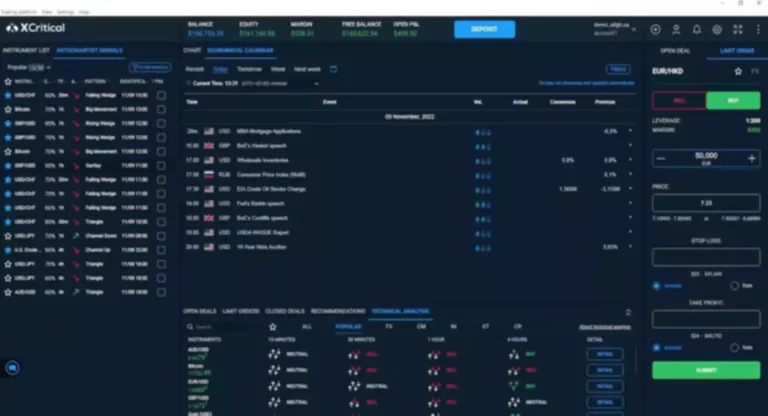Content
This is why reviews and word of mouth marketing are still such an essential part of business in 2020. Without having the option of calling your customers up repeatedly to try and sell to them, you need to find other ways to Prime Brokerage bring them to your company. By focusing on business intelligence in your customer experience function, you can create a broader appreciation of BI across the business.
Effective reporting and communication
Microsoft Power BI is a powerful business analytics tool that allows users to visualize their data and share insights across their organizations, or embed them in an app or website. It benefits business operations through a group of systems, technologies, and procedures. BI services is a software and service package that converts data into usable broker business intelligence software intelligence.

Make better decisions with your data.

Business intelligence tools help organizations make more out of their data through advanced data analytics, powerful reporting, and easy-to-read data visualizations. BI is designed to answer specific queries and provide at-a-glance analysis for decisions or planning. However, companies can use the processes of analytics to continually improve follow-up questions and iteration. Business analytics shouldn’t be a linear process because answering one question will https://www.xcritical.com/ likely lead to follow-up questions and iteration.
Why is a Data Analytics Maturity Assessment Important?
In order to execute these steps, multiple tools and products need to be employed. You rely on UPS to deliver your product on time and intact because ultimately this will reflect back on your brand. By analyzing customer interactions — through transaction history, browsing behavior, customer service channels, etc. — they are uncovering new and unexpected ways to improve their customer service.
- ” Business intelligence takes those models and algorithms and breaks the results down into actionable language.
- BI is about analyzing where the company is today and where it was in the past.
- Businesses can optimize productivity and customer satisfaction by having a well-balanced team with appropriate skill sets.
- However, the term ‘business intelligence’ wasn’t coined until the late 1980s.
- By using BI tools in various departments, your team can collect and aggregate that data to make informed business decisions.
- Individuals that handle business analytics, typically have a background in mathematics or statistics or an online masters degree in business analytics.
BI tools help to filter out inaccuracies in data at the pre-processing phase. There are always gaps in data, and filling those gaps requires a skillful approach. Self-service BI tools’ primary goal is to give decision-makers real-time insights about the company and the market.
The tools surface trends in consumer behavior that companies can use to create more effective marketing strategies and improve customer experience. In 2023, businesses are increasingly relying on integrated business applications and analytics computing capacity to gain valuable insights into their operations. With the growing trend of focused businesses, it has become imperative for organizations to use business intelligence and services analytics to make informed decisions. With business intelligence tools, for example, businesses can improve their operations, identify trends, optimize resources, and stay ahead of competitors. Moreover, actionable insights help businesses develop a more comprehensive understanding of the market situation.

Holding your team accountable can increase loyalty by providing each person with a clear understanding of their role and reducing confusion among departments. The term “business intelligence” first appeared in the 1960s to describe a system for sharing information among departments. Today, BI tools enable self-service data management and digital data analysis. By 2033, the global business intelligence market is expected to grow to $26.5 billion, Market.us reports.
Take note if there are different account types, if there are separate creator, editor, or viewer user accounts. Check if it is possible for multiple users to work collaboratively on the same dashboard. Business analytics, on the other hand, is concerned with predictive and prescriptive analytics. This type of analysis is concerned with predicting what will happen next, or what a company should be doing next. Performing BA tends to be a more specialized pursuit, since it requires a good descriptive and diagnostic foundation that comes from BI.
As new data becomes available or business conditions change, BI solutions need to be adjusted and updated to ensure ongoing relevance and accuracy. Before going into the details, it is highly pertinent to clear up the confusion that frequently pops up regarding the overlapping of Business Intelligence (BI) and Business Analytics (BA). In the simplest terms, Business Intelligence (BI) is concerned with the descriptive and diagnostic levels of analysis. Whereas Business Analytics (BA) is concerned with predictive and prescriptive analysis; what a company should do in the future. BI is often synonymous with competitive intelligence and is also confused with business analytics.
Self-service BI refers to the ability for non-technical users to get accurate analytics and insights directly from BI tools without involving (and waiting for) IT. Business intelligence is the combination of software and services that turn raw data from internal and external systems into actionable insights. These insights inform an organization’s strategic and day-to-day business decisions. Business intelligence includes data analytics and business analytics but uses them only as parts of the whole process. Data scientists dig into the specifics of data, using advanced statistics and predictive analytics to discover patterns and forecast future patterns. It can be safely argued that with the rapid advancement in technology, businesses that harness the power of BI are better positioned for success in the modern competitive marketplace.
Business intelligence analyzes current operational data to drive decision-making, while business analytics delves deeper into predictive insights for future growth. Ultimately, business intelligence drives global economic growth, as it helps organizations identify trends, optimize operations, and seize new opportunities. BI is a set of tools and techniques that enable organizations to collect, analyze, and report on data to make informed business decisions.
However, with advancements in cloud technology, analytical tools have become much more accessible and data is abundant. Using best practices for BI, organizations can make decisions informed by analyzing past and present data, deriving insights, and implementing strategies based on those insights. This type of digital transformation initiative has played a major role in empowering organizations to embrace modern technology that enhances operations and streamlines processes. BI is, first and foremost, a platform that uses data to provide business leaders with powerful insights that inform decisions. Business intelligence platforms work by consolidating and organizing data which users can then run queries against to generate data visualizations and other reports. Traditional business intelligence is still a common approach for regular reporting and answering static queries.
BI benefits organizations that want to be data-driven, adaptable, and growth-minded. This blog discusses the top ten reasons business intelligence consultants use power BI. Its user-friendly interface makes it accessible for users of all levels, significantly reducing training time and enhancing productivity.
